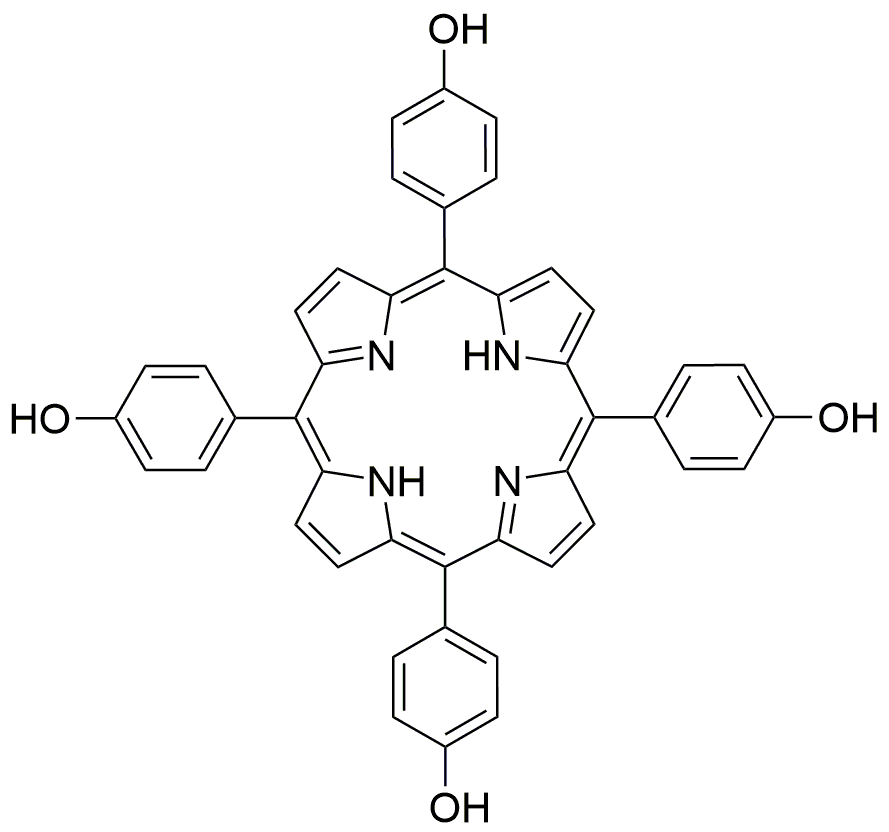5,10,15,20-Tetrakis(4-hydroxyphenyl)porphyrin is widely utilized in research focused on:
- Photodynamic Therapy (PDT): This compound is effective in treating certain cancers by generating reactive oxygen species when exposed to light, helping to destroy cancer cells.
- Solar Energy Conversion: Its unique structure allows for efficient light absorption, making it a valuable component in developing solar cells and other energy conversion technologies.
- Fluorescent Probes: Used in biomedical research, it serves as a fluorescent marker for imaging and tracking biological processes in living organisms.
- Antioxidant Applications: The compound exhibits antioxidant properties, which can be beneficial in formulating products aimed at reducing oxidative stress in various industries, including cosmetics and food preservation.
- Catalysis: It plays a significant role in catalyzing chemical reactions, particularly in organic synthesis, providing a more efficient pathway compared to traditional catalysts.
General Information
Properties
Safety and Regulations
Applications
5,10,15,20-Tetrakis(4-hydroxyphenyl)porphyrin is widely utilized in research focused on:
- Photodynamic Therapy (PDT): This compound is effective in treating certain cancers by generating reactive oxygen species when exposed to light, helping to destroy cancer cells.
- Solar Energy Conversion: Its unique structure allows for efficient light absorption, making it a valuable component in developing solar cells and other energy conversion technologies.
- Fluorescent Probes: Used in biomedical research, it serves as a fluorescent marker for imaging and tracking biological processes in living organisms.
- Antioxidant Applications: The compound exhibits antioxidant properties, which can be beneficial in formulating products aimed at reducing oxidative stress in various industries, including cosmetics and food preservation.
- Catalysis: It plays a significant role in catalyzing chemical reactions, particularly in organic synthesis, providing a more efficient pathway compared to traditional catalysts.
Documents
Safety Data Sheets (SDS)
The SDS provides comprehensive safety information on handling, storage, and disposal of the product.
Product Specification (PS)
The PS provides a comprehensive breakdown of the product’s properties, including chemical composition, physical state, purity, and storage requirements. It also details acceptable quality ranges and the product's intended applications.
Certificates of Analysis (COA)
Search for Certificates of Analysis (COA) by entering the products Lot Number. Lot and Batch Numbers can be found on a product’s label following the words ‘Lot’ or ‘Batch’.
*Catalog Number
*Lot Number
Certificates Of Origin (COO)
This COO confirms the country where the product was manufactured, and also details the materials and components used in it and whether it is derived from natural, synthetic, or other specific sources. This certificate may be required for customs, trade, and regulatory compliance.
*Catalog Number
*Lot Number
Safety Data Sheets (SDS)
The SDS provides comprehensive safety information on handling, storage, and disposal of the product.
DownloadProduct Specification (PS)
The PS provides a comprehensive breakdown of the product’s properties, including chemical composition, physical state, purity, and storage requirements. It also details acceptable quality ranges and the product's intended applications.
DownloadCertificates of Analysis (COA)
Search for Certificates of Analysis (COA) by entering the products Lot Number. Lot and Batch Numbers can be found on a product’s label following the words ‘Lot’ or ‘Batch’.
*Catalog Number
*Lot Number
Certificates Of Origin (COO)
This COO confirms the country where the product was manufactured, and also details the materials and components used in it and whether it is derived from natural, synthetic, or other specific sources. This certificate may be required for customs, trade, and regulatory compliance.


